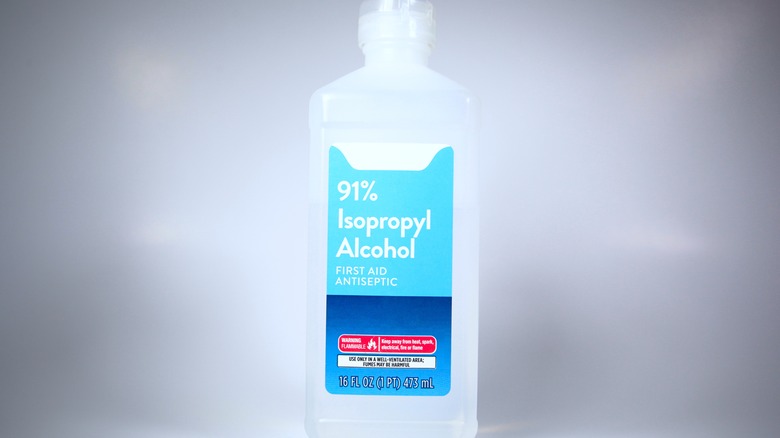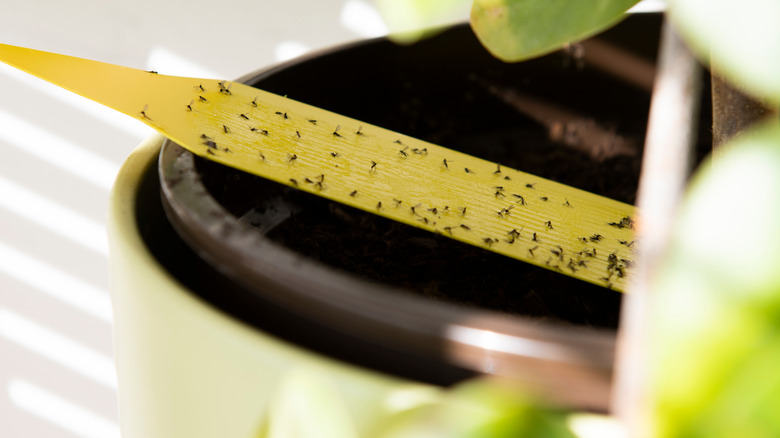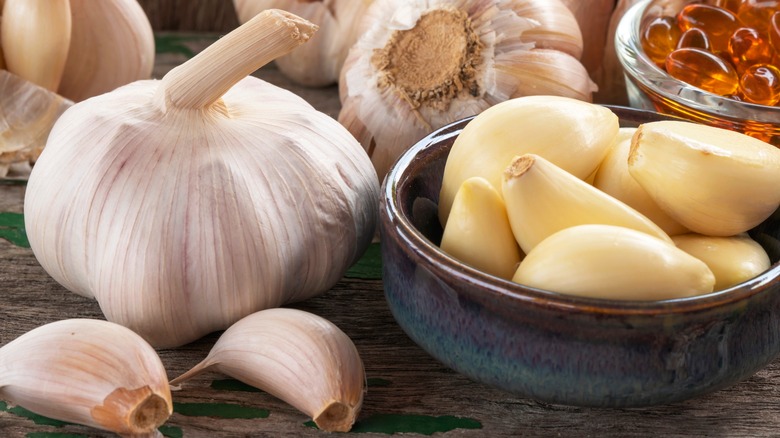How To Get Rid Of Aphids
Whether your green thumb manifests through an indoor houseplant collection, beautiful beds of flowers, or bountiful crops, gardening is a great and rewarding hobby. For those who dedicate time and energy to plant care, there are few things more heartbreaking than noticing your plant has a pest infestation.
One of the most common pests to plague both indoor and outdoor plants are aphids. According to University of Minnesota Extension, aphids are small insects that can be winged or wingless and found in various colors, including black, gray, green, yellow, brown, and red. You likely won't notice the insect itself, but more of a white, scaly-looking pattern — this is the aphid's discarded exoskeleton. You can also identify aphid presence by the sticky residue they leave behind after feeding, called honeydew.
Aphids are usually not a major cause for concern, but once you notice them, the infection has usually become severe. Common signs of an aphid problem include stunted or lackluster plant growth, dead or dying offshoots and new growth, and leaves curling, twisting, and yellowing. Luckily, aphid infestation isn't a major concern and there are plenty of ways to get rid of them.
1. Soap and water
Before trying out any preventative methods, it's important to immediately quarantine your affected plant. This involves moving any affected plants away from healthy ones and checking other plants for possible infection. The simplest method of aphid control is simply spraying them with water. Tips Bulletin says one of the most effective and easiest ways to get rid of aphids, especially on outdoor plants and tomatoes, is to spray them with a steady, firm stream of water — just make sure it isn't too strong that it knocks off leaves. For indoor plants, run your plants under a stream of water in your sink or shower, which will knock off most of the aphids.
Aphids are incredibly small and may linger still. There will also be leftover honeydew. Take care of this by mixing 5 tablespoons of gentle dish soap with 1 gallon of water, and add to a spray bottle. Thoroughly spray down your plants, paying special attention to the stems and underneath leaves and petals. Repeat weekly or as needed.
2. Neem oil
Some plants, both indoors and out, won't react well to the dish soap spray. Additionally, if the infestation is severe enough, it may not be enough to kill the aphids. This is why Laidback Gardener recommends using neem oil to control your aphid problem. Neem oil is an incredibly effective pest repellent that is entirely natural and organic. It is often found at gardening supply centers or nurseries, both in its pure form and as a pre-diluted spray. Neem oil will not only kill the aphids, but it will also prevent any leftover or future aphids from being able to reproduce.
If you purchased a pre-diluted neem oil mixture, it likely already comes with a spray attachment. If you bought just the oil, dilute it with water according to the instructions on the bottle, and add to a spray bottle. Liberally spray down your plants, especially the underside of leaves, in between petals, and on the stem and base. Repeat every five days or so until all signs of the pests are gone.
3. Rubbing alcohol
Another way to get rid of aphids and other pests they have attracted is with rubbing alcohol, suggests Tips Bulletin. While the other methods are meant to drown the aphids in either the soap or neem oil, this method will dry out the insects and kill them. For this method, you'll need either rubbing alcohol or isopropyl alcohol, water, and either a spray bottle or cotton swab. Begin by mixing the ingredient together in equal parts. If you have particularly sensitive plants or crops, or ones that are prone to drying out, use more water.
If you only have a few straggling aphids, you can simply dip a cotton swab in the mixture and spot kill them. However, if you have a more serious infestation, add the mixture to a spray bottle and thoroughly spray the plant down. Repeat this twice a week until all signs of the aphids are gone.
4. Ladybugs
A great way to deal with aphids is to target their natural environment. While this method may seem counterintuitive, an effective method of controlling aphids is by introducing other bugs into your garden. Specifically, Garden Betty recommends hoverflies, geocoris (big-eyed bugs), nabidae (damsel bugs), lacewings, parasitic wasps, and, most effectively, ladybugs.
All of the above insects and their larvae eat aphids, among other pests, and are also beneficial to your garden in a variety of other ways. Ladybugs can be attracted by planting pollinator-friendly flowers, or they can also be found either live or frozen at garden centers towards the beginning of the spring growing season. Alternatively, if you can deal with their presence, parasitic wasps are the most effective killer. They spread parasites to aphids as they are born, and some aphid colonies will simply abandon certain plants and die of starvation rather than dealing with the wasps.
5. Fly paper
One of the trickiest parts of killing off an aphid infestation is finding them, since they're so small and often blend in with the plant's leaves and stem. This is why Hort Zone recommends using fly tape to expose the colony. Fly tape or fly paper exposes most insects' phototaxis, which is essentially their instinctual pull toward light sources or things that resemble light. As such, most pests, aphids included, have a strong impulse to investigate anything bright yellow. Fly tape is, as the name would suggest, sticky, and traps the curious bug until it dies.
Fly paper will effectively expose how many aphids you have, as well as keep them from feeding on and subsequently damaging the plant. Fly paper is an effective tool for both indoor and outdoor plants. Indoors, fly tape is usually staked in the base of the plant or just near it. Outdoors, you can wrap the tape on the rims of potted plants, or stake them by the base and as close to the leaves of in-ground plants.
6. Diatomaceous earth
A more natural and organic way of dehydrating and killing aphids is through the use of diatomaceous earth, explains Almanac. Diatomaceous earth is a white, powdery substance sold at most gardening centers and home improvement stores, and is made up of the crushed fossilized skeletons of diatoms, which are aquatic, single-celled organisms that naturally contain silica.
Diatomaceous earth works to deter pests in a number of ways. The powder is quite sharp to most bugs and feels like walking on glass. If the bug gets cut, the diatomaceous earth dries it out until it dies. If it doesn't get cut, particles will still get into pests' joints and dehydrate them that way. Diatomaceous earth should not be applied during blooming seasons, since it will also kill helpful pollinators and beneficial insects. You can apply by either spreading a ring around your plant, on the leaves (but not flowers), or on dry plants.
7. Garlic
While many of us enjoy the smell of garlic-rich dishes, most insects, aphids included, strongly dislike the smell. Tips Bulletin recommends using the vegetable to keep aphids away from both your house and outdoor plants. Begin by mincing or crushing multiple garlic cloves as finely as possible, which will allow more oil and odor to be released. Add the crushed garlic to a spray bottle with a pint of warm water, 4 teaspoons of vegetable oil, 1 teaspoon of mild and gentle dish soap, and shake vigorously.
Spray your affected plants and any nearby ones thoroughly with the mixture. Again, pay special attention to in between and under the leaves, the stem, and the base — anywhere the aphids will likely hide or be unnoticeable. It won't hurt the plants, but the garlic will deter the aphids, and the oil and dish soap will trap and drown those that stay.
8. Pest repellent plants
Garlic isn't the only scent that repels aphids. There are plenty of plants that are well known for their pest repellent reputation, as they give off a scent that most insects and garden pests find upsetting. As a bonus, the smells are often not just palatable for humans, but also enjoyable. Some popular flowers to grow for repelling aphids include marigold and catnip, according to Garden Betty. Plant them interspersed with your crops, or as a border to prevent aphids from coming in at all. You can also grow potted versions of these flowers next to your indoor plants.
In addition, there are also some great companion herbs, which will keep aphids away while yielding delicious, fresh seasonings for cooking. Some of these herbs include peppermint, dill, chives, cilantro, and fennel. Again, plant them between affected plants, as a border, or in pots for inside the home.
9. Essential oil
If growing herbs isn't in your skill set, don't worry. There's still a way to deter aphids using herbaceous scents without having to keep yet another plant alive. According to Tips Bulletin, you can use essential oils as an effective repellant. In particular, you should opt for clove, rosemary, thyme, or peppermint. The oil will smother and kill the aphids already on your plant, along with any eggs the insect has laid. In addition, it will deter any surviving aphids and other pests from feeding on your plant in the future.
Straight essential oil will possibly dry out your plant, so you'll need to dilute it. Do so by combining 1 teaspoon of the essential oil of your choosing, 1 teaspoon of a mild and gentle dish soap, and 8 ounces of distilled or filtered water in a spray bottle. Spray the mixture on the leaves, stems, and the top of your plant's soil.









